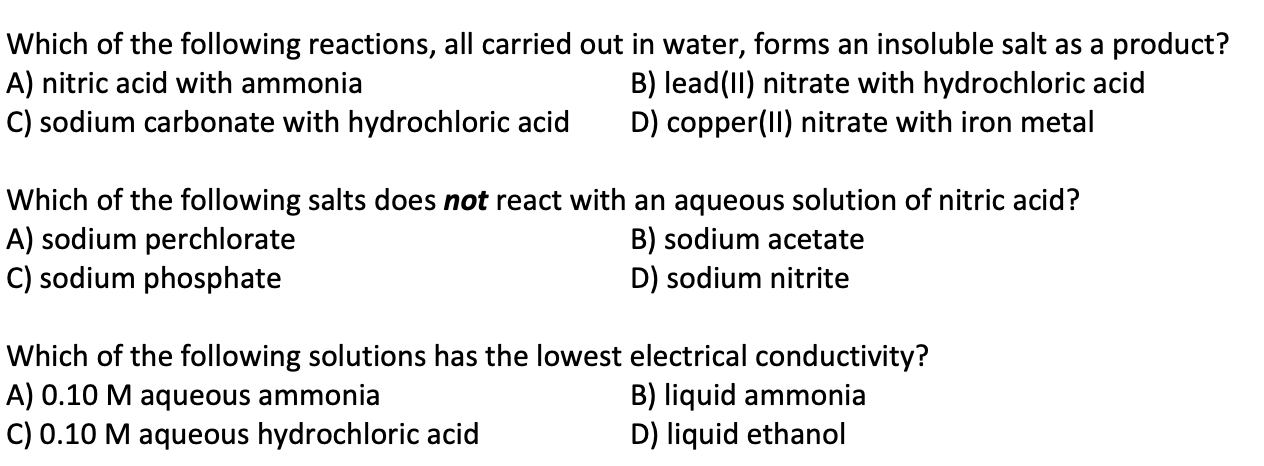Which of the following reactions, all carried out in water, forms an insoluble salt as a product? A) nitric acid with ammonia C) sodium carbonate with hydrochloric acid B) lead(II) nitrate with hydrochloric acid D) copper(II) nitrate with iron metal Which of the following salts does not react with an aqueous solution of nitric acid? A) sodium perchlorate C) sodium phosphate B) sodium acetate D) sodium nitrite Which of the following solutions has the lowest electrical conductivity? A) 0.10 M aqueous ammonia C) 0.10 M aqueous hydrochloric acid B) liquid ammonia D) liquid ethanol
Which of the following reactions, all carried out in water, forms an insoluble salt as a product? A) nitric acid with ammonia C) sodium carbonate with hydrochloric acid B) lead(II) nitrate with hydrochloric acid D) copper(II) nitrate with iron metal Which of the following salts does not react with an aqueous solution of nitric acid? A) sodium perchlorate C) sodium phosphate B) sodium acetate D) sodium nitrite Which of the following solutions has the lowest electrical conductivity? A) 0.10 M aqueous ammonia C) 0.10 M aqueous hydrochloric acid B) liquid ammonia D) liquid ethanol
Chemistry: Principles and Reactions
8th Edition
ISBN:9781305079373
Author:William L. Masterton, Cecile N. Hurley
Publisher:William L. Masterton, Cecile N. Hurley
Chapter4: Reactions In Aqueous Solution
Section: Chapter Questions
Problem 71QAP: Calcium in blood or urine can be determined by precipitation as calcium oxalate, CaC2O4. The...
Related questions
Question

Transcribed Image Text:Which of the following reactions, all carried out in water, forms an insoluble salt as a product?
A) nitric acid with ammonia
C) sodium carbonate with hydrochloric acid
B) lead(II) nitrate with hydrochloric acid
D) copper(II) nitrate with iron metal
Which of the following salts does not react with an aqueous solution of nitric acid?
A) sodium perchlorate
C) sodium phosphate
B) sodium acetate
D) sodium nitrite
Which of the following solutions has the lowest electrical conductivity?
A) 0.10 M aqueous ammonia
C) 0.10 M aqueous hydrochloric acid
B) liquid ammonia
D) liquid ethanol
Expert Solution
This question has been solved!
Explore an expertly crafted, step-by-step solution for a thorough understanding of key concepts.
This is a popular solution!
Trending now
This is a popular solution!
Step by step
Solved in 4 steps with 9 images

Knowledge Booster
Learn more about
Need a deep-dive on the concept behind this application? Look no further. Learn more about this topic, chemistry and related others by exploring similar questions and additional content below.Recommended textbooks for you

Chemistry: Principles and Reactions
Chemistry
ISBN:
9781305079373
Author:
William L. Masterton, Cecile N. Hurley
Publisher:
Cengage Learning

Introductory Chemistry: A Foundation
Chemistry
ISBN:
9781337399425
Author:
Steven S. Zumdahl, Donald J. DeCoste
Publisher:
Cengage Learning

General Chemistry - Standalone book (MindTap Cour…
Chemistry
ISBN:
9781305580343
Author:
Steven D. Gammon, Ebbing, Darrell Ebbing, Steven D., Darrell; Gammon, Darrell Ebbing; Steven D. Gammon, Darrell D.; Gammon, Ebbing; Steven D. Gammon; Darrell
Publisher:
Cengage Learning

Chemistry: Principles and Reactions
Chemistry
ISBN:
9781305079373
Author:
William L. Masterton, Cecile N. Hurley
Publisher:
Cengage Learning

Introductory Chemistry: A Foundation
Chemistry
ISBN:
9781337399425
Author:
Steven S. Zumdahl, Donald J. DeCoste
Publisher:
Cengage Learning

General Chemistry - Standalone book (MindTap Cour…
Chemistry
ISBN:
9781305580343
Author:
Steven D. Gammon, Ebbing, Darrell Ebbing, Steven D., Darrell; Gammon, Darrell Ebbing; Steven D. Gammon, Darrell D.; Gammon, Ebbing; Steven D. Gammon; Darrell
Publisher:
Cengage Learning

Chemistry: Principles and Practice
Chemistry
ISBN:
9780534420123
Author:
Daniel L. Reger, Scott R. Goode, David W. Ball, Edward Mercer
Publisher:
Cengage Learning

World of Chemistry, 3rd edition
Chemistry
ISBN:
9781133109655
Author:
Steven S. Zumdahl, Susan L. Zumdahl, Donald J. DeCoste
Publisher:
Brooks / Cole / Cengage Learning

Living By Chemistry: First Edition Textbook
Chemistry
ISBN:
9781559539418
Author:
Angelica Stacy
Publisher:
MAC HIGHER